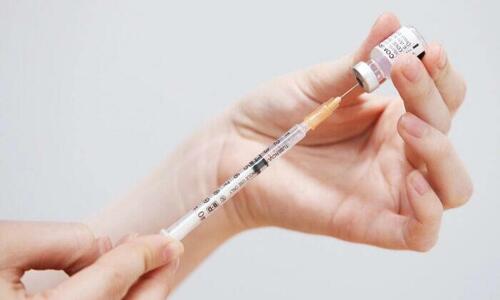It is much worse than we were told! When you were injected with the mRNA vaccine, the RNA didn't necessarily stay in your arm as it was supposed to do. Often it migrated and infected cells randomly. These cells started producing the spikes and were of course immediately destroyed by your immune system. Whenever this was in the heart, it would cause irremediable inflammations. Worse, we now know that the mRNA technology is not yet mature and consequently, the samples contain huge numbers of RNA "debris". What effects do these have on the body? Well, your guess is as good as mine. Except of you look at which type of diseases have been exploding since 2021: Myocarditis, Turbo cancers and a litany of rare diseases we hardly ever saw before. Coincidence or correlation?
Authored by Zachary Stieber via The Epoch Times (emphasis ours),
Heart scarring was detected more than one year after COVID-19 vaccination in some people who suffered myocarditis following receipt of a shot, researchers reported in new studies.

A third of 60 patients with follow-up cardiac imaging done more than 12 months after their myocarditis diagnosis had persistent late gadolinium enhancement (LGE), which is, in the majority of cases, reflective of heart scarring, Australian researchers reported in a preprint of a new study, published on March 22.
Myocarditis is a form of heart inflammation.
The median time from receipt of a vaccine to follow-up imaging was 548 days, with the longest interval being 603 days.
“We found that the incidence of persistent myocardial fibrosis is high, seen in almost a third of patients at >12 months post diagnosis, which could have implications for the management and prognosis of this predominantly young cohort,” the researchers wrote.
“The long-term clinical implications of LGE in this condition are as yet unknown, but LGE has been demonstrated to confer worse prognosis in non-COVID-19 vaccine-associated myocarditis, especially if it persists beyond six months,” they added later, pointing to several previous papers.
Researchers in one of the previous papers, for instance, found that LGE was a “powerful prognosticator” of adverse outcomes in myocarditis patients.
Before the new testing, nine patients were determined to definitely have myocarditis, and 58 patients were labeled as probably having myocarditis. The findings of persistent LGE resulted in reclassifying 16 of the cases from probable myocarditis to definite myocarditis.
Exclusions included patients who were pregnant or allergic to agents used in gadolinium testing.
Among a subset of 20 patients who underwent imaging shortly after vaccination, 19 had LGE. In follow-up imaging, LGE was no longer visible in 10 of those patients. In five, it was reduced, but in four it was unchanged.
Andrew Taylor, a professor at Monash University’s Central Clinical School, and his co-authors conducted the study by recruiting patients who were diagnosed with myocarditis associated with COVID-19 vaccination between August 2021 and March 2022. The patients were invited to undergo imaging at Alfred Hospital or Royal Children’s Hospital in Melbourne, Australia.
The study population with follow-up imaging included 44 adults and 16 adolescents.
Most of the patients had received a Pfizer-BioNTech shot. A minority had received a Moderna or AstraZeneca vaccination. The companies did not respond to requests for comment.
Limitations of the paper, which was published ahead of peer review, included possible selection bias, since participation in the study was voluntary. Authors listed no conflicts of interest or funding.
Another Paper
In the other recent paper, researchers in Canada reported finding about half of patients referred for imaging due to possible post-vaccination myocarditis had persistent LGE in follow-up imaging.
Overall, 60 patients were included in the retrospective study. Of those, seven reported persistent symptoms.
In a subset of 21 patients for whom follow-up MRIs were available, 10 had persistent LGE, the researchers said. On the other hand, function of the left ventricle, which pumps blood, had normalized in all patients.
The persistent LGE “likely reflects replacement fibrosis,” or heart scarring, Dr. Kate Hanneman, with the University of Toronto’s Department of Medical Imaging, and her co-authors wrote. They cited some of the same papers as the Australian group, including the study that found patients with persistent LGE had a higher risk of adverse outcomes, as well as a paper on what it represents when LGE is found on MRI in patients with myocarditis.
“However, the significance of LGE is uncertain in patients post-myocarditis with recovered normal left ventricular systolic function,” the researchers said. They called for additional studies to evaluate patients with persistent LGE and a recovered left ventricle.
The study included adult patients who were referred to a hospital network with suspected myocarditis and had new cardiac symptoms such as chest pain within 14 days of COVID-19 vaccination. The patients all received either the Pfizer or Moderna shot.
Limitations of the study, which was published by the Journal of Cardiovascular Magnetic Resonance, included a lack of biopsy-confirmed myocarditis.
The authors declared no funding and listed only one competing interest, that an author is an associate editor of the journal.
The corresponding authors for the two papers did not respond to requests for comment.
“My concern from reading these two studies is that myocardial damage and scarring is present in a significant number of COVID vaccine injured individuals at up to 18 months after vaccination. This suggests potential for permanent heart damage from the vaccines,” Dr. Danice Hertz, the research lead for the U.S. group React19, told The Epoch Times in an email. “The long-term implications are not yet known but need to be studied carefully.”
Earlier Findings
The new papers add to earlier studies, which found that LGE persists for months in some people following a COVID-19 shot.
Researchers in Washington state reported in 2022 that LGE persisted in children for up to eight months after vaccination. Later that year, the U.S. Centers for Disease Control and Prevention (CDC) said that more than half of 151 patients with follow-up imaging had residual LGE, which was described as “suggestive of myocardial scarring.”
The CDC has longer-term data on the patients, the agency confirmed to The Epoch Times in January, but has not yet published another paper describing that data. The CDC, which failed to warn the public about the risk of post-vaccination myocarditis, declined to comment on the new Australian and Canadian papers.
Hong Kong researchers in 2023 reported finding that about half of 40 patients with follow-up MRIs months after vaccination had LGE.
Symptoms have also persisted in some patients with post-vaccination myocarditis.
The CDC, describing preliminary updated results from its longer-term study, said in early 2023 that there were patients still suffering from symptoms more than one year after a shot. Researchers in Australia in late 2023 said that symptoms persisted at least six months after a shot in a majority of patients they followed. And some patients also told The Epoch Times they have lingering health issues years after vaccination.


No comments:
Post a Comment